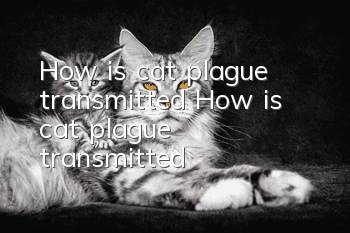How is cat plague transmitted? How is cat plague transmitted?

How is feline distemper transmitted? Feline distemper is the most likely disease for cats. Cats must be treated as early as possible, because if feline distemper is serious, it will be contagious. So what are the ways of transmitting feline distemper?
How cats are infected
Cats are very tolerant animals. In the early stages of feline plague, it may not be easy to detect. It is manifested by symptoms such as poor energy, long sleep time, unwillingness to eat, and drooling at the mouth. In the middle stage, such symptoms The symptoms are more obvious, and in severe cases, the patient may refuse to eat. People who raise cats should take a closer look at the cat's condition and take its temperature as soon as possible. Timely and earlier detection is more conducive to treatment and recovery. Cats will still be very strong and behave in some ways, but when cats are sick, they will not be so strong. So how is cat plague transmitted? According to the above introduction of cat plague, do you know how cat plague is transmitted? So, I hope everyone will make a judgment based on some of the cats’ symptoms. If a cat has feline distemper, it should be detected promptly and effectively to avoid infecting other cats and putting more cats at risk.
Feline distemper is the most likely disease for cats. Cats must be treated as early as possible to allow the cat to recover as soon as possible, because if the feline distemper is serious, it will be contagious.
Feline distemper, also known as feline infectious enteritis, is an acute and highly contagious infectious disease of cats. The main clinical manifestations are sudden high fever, diarrhea, circulatory disorders and a sharp decrease in white blood cells. All cases of leukopenia are feline plague. Other diseases can also cause leukopenia. If a female cat is infected during pregnancy, she will Causes stillbirth and neurological symptoms in born kittens.
How cat plague is transmitted is through contact with virus-containing urine, feces and bugs. The causative agent is Parvoviridae. After this virus enters the body, it can survive in the kidneys for at least one year. And this parvovirus can survive in the environment for a long time, but can be killed by formalin, etc.
How is feline plague transmitted? Cats infected with the disease can excrete a large amount of virus from their feces and various secretions, and the virus can survive in the environment for a long time. Recovered cats must detoxify for at least a year. Cats in the infection stage can also be spread by blood-sucking insects such as fleas, lice, mosquitoes and flies.
The incubation period of this disease is several days. Clinically, the symptoms shown by cats are related to their age and the virulence of the virus. Young cats often suffer from acute illness, with elevated body temperature and violent vomiting. Many cats do not show any symptoms and die suddenly. Most cats that are more than a few months old show subacute symptoms. They first have a fever of about 40 degrees, which is a biphasic form of fever. Cats infected with feline plague are in low spirits, do not eat, and their vomit is yellow-green, and their mouth and eyes areThere is sticky secretion from the nose, and when diarrhea occurs, it means that the animal is in the late stage of the disease, with blood in the feces, severe dehydration, and death. Feline distemper, also known as feline infectious enteritis, is an acute and highly contagious infectious disease of cats.
Based on the above introduction to cat plague, have you understood how cat plague is transmitted? I hope you can make judgments based on some of the cat’s symptoms. If a cat has cat plague, it must be detected in a timely and effective manner. As for avoiding the infection to other cats, more cats will be harmed.
- Can cats drink Huoxiang Zhengqi water?
- Cats are adorable, do you know how to feed kittens scientifically?
- How to raise Burmese cats Burmese cat raising tips
- How to raise British Shorthair cats British Shorthair feeding tips
- Cat bleeds after giving birth
- What are the characteristics of feline calicivirus?
- What causes cat urethral hyperplasia?
- At what age can cats be vaccinated against rabies?
- How many days does it take for a newborn kitten to pass through the dangerous period?
- Can Siamese cats eat live fish?



